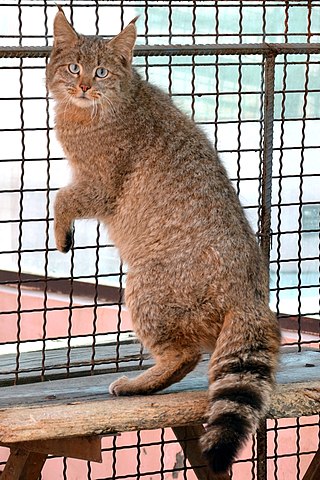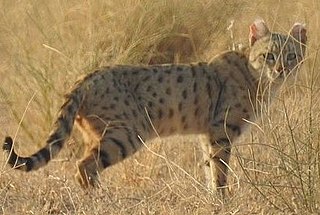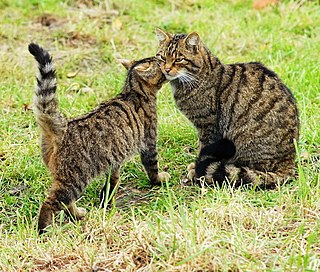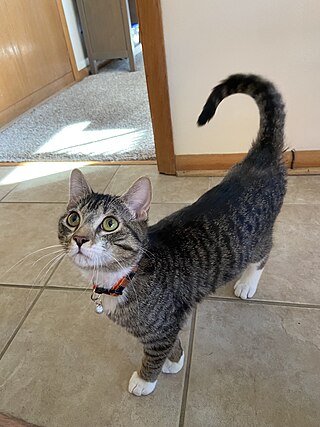Related Research Articles

The cat is a domestic species of small carnivorous mammal. It is the only domesticated species in the family Felidae and is commonly referred to as the domestic cat or house cat to distinguish it from the wild members of the family. Cats are commonly kept as house pets but can also be farm cats or feral cats; the feral cat ranges freely and avoids human contact. Domestic cats are valued by humans for companionship and their ability to kill rodents. About 60 cat breeds are recognized by various cat registries.

Felidae is the family of mammals in the order Carnivora colloquially referred to as cats. A member of this family is also called a felid. The term "cat" refers both to felids in general and specifically to the domestic cat.

Felis is a genus of small and medium-sized cat species native to most of Africa and south of 60° latitude in Europe and Asia to Indochina. The genus includes the domestic cat. The smallest Felis species is the black-footed cat with a head and body length from 38 to 42 cm. The largest is the jungle cat with a head and body length from 62 to 76 cm.

The wildcat is a species complex comprising two small wild cat species: the European wildcat and the African wildcat. The European wildcat inhabits forests in Europe, Anatolia and the Caucasus, while the African wildcat inhabits semi-arid landscapes and steppes in Africa, the Arabian Peninsula, Central Asia, into western India and western China. The wildcat species differ in fur pattern, tail, and size: the European wildcat has long fur and a bushy tail with a rounded tip; the smaller African wildcat is more faintly striped, has short sandy-gray fur and a tapering tail; the Asiatic wildcat is spotted.

The Chinese mountain cat, also known as Chinese desert cat and Chinese steppe cat, is a small wild cat endemic to western China that has been listed as Vulnerable on the IUCN Red List since 2002, as the effective population size may be fewer than 10,000 mature breeding individuals.

A feral cat or a stray cat is an unowned domestic cat that lives outdoors and avoids human contact: it does not allow itself to be handled or touched, and usually remains hidden from humans. Feral cats may breed over dozens of generations and become an aggressive local apex predator in urban, savannah and bushland environments. Some feral cats may become more comfortable with people who regularly feed them, but even with long-term attempts at socialization, they usually remain aloof and are most active after dusk.

A felid hybrid is any of a number of hybrids between various species of the cat family, Felidae. This article deals with hybrids between the species of the subfamily Felinae.
The Cretan wildcat is a member of the genus Felis that inhabits the Greek island of Crete. Its taxonomic status is unclear at present, as some biologists consider it probably introduced, or a European wildcat, or a hybrid between European wildcat and domestic cat. It was previously considered a separate subspecies of wildcat as Felis silvestris cretensis.

The European wildcat is a small wildcat species native to continental Europe, Scotland, Turkey and the Caucasus. It inhabits forests from the Iberian Peninsula, Italy, Central and Eastern Europe to the Caucasus. Its fur is brownish to grey with stripes on the forehead and on the sides and has a bushy tail with a black tip. It reaches a head-to-body length of up to 65 cm (26 in) with a 34.5 cm (13.6 in) long tail, and weighs up to 7.5 kg (17 lb).

The Asiatic wildcat, also known as the Asian steppe wildcat and the Indian desert cat, is an African wildcat subspecies that occurs from the eastern Caspian Sea north to Kazakhstan, into western India, western China and southern Mongolia. There is no information on current status or population numbers across the Asiatic wildcat's range as a whole, but populations are thought to be declining.

The African wildcat is a small wildcat species with sandy grey fur, pale vertical stripes on the sides and around the face. It is native to Africa, West and Central Asia, and is distributed to Rajasthan in India and Xinjiang in China. It inhabits a broad variety of landscapes ranging from deserts to savannas, shrublands and grasslands.

The Sardinian wildcat is an isolated population of feral cats on the island of Sardinia, introduced during the Roman Empire. It has historically been misidentified as a species of lynx or a subspecies of wildcat.
The Corsican wildcat is an isolated feral cat population that used to be considered a subspecies of the African wildcat, but is now thought to have been introduced to Corsica around the beginning of the first millennium.

The Caucasian wildcat is a European wildcat subspecies that inhabits the Caucasus Mountains and Turkey.
Felis chaus chaus is the nominate subspecies of the jungle cat.

Felis lunensis, or the Martelli's cat is an extinct felid of the subfamily Felinae.

The Scottish wildcat is a European wildcat population in Scotland. It was once widely distributed across Great Britain, but the population has declined drastically since the turn of the 20th century due to habitat loss and persecution. It is now limited to northern and eastern Scotland. Camera-trapping surveys carried out in the Scottish Highlands between 2010 and 2013 revealed that wildcats live foremost in mixed woodland, whereas feral and domestic cats were photographed mostly in grasslands.

The Southern African wildcat is an African wildcat subspecies native to Southern and Eastern Africa. In 2007, it was tentatively recognised as a distinct subspecies on the basis of genetic analysis. Morphological evidence indicates that the split between the African wildcat subspecies in Africa occurred in the area of Tanzania and Mozambique.

The Arabian wildcat, also called Gordon's wildcat is a wildcat subspecies that inhabits the Arabian Peninsula.

The domestic cat originated from Near-Eastern and Egyptian populations of the African wildcat, Felis sylvestris lybica. The family Felidae, to which all living feline species belong, arose about ten to eleven million years ago. This family is divided into eight major phylogenetic lineages. The domestic cat is a member of the Felis lineage. A number of investigations have shown that all domestic varieties of cats come from a single species of the Felis lineage, Felis catus. Variations of this lineage are found all over the world and up until recently scientists have had a hard time pinning down exactly which region gave rise to modern domestic cat breeds. Scientists believed that it was not just one incident that led to the domesticated cat but multiple, independent incidents at different places that led to these breeds. More complications arose from the fact that the wildcat population as a whole is very widespread and very similar to one another. These variations of wildcat can and will interbreed freely with one another when in close contact, further blurring the lines between taxa. Recent DNA studies, advancement in genetic technologies, and a better understanding of DNA and genetics as a whole has helped make discoveries in the evolutionary history of the domestic cat. Archaeological evidence has documented earlier dates of domestication than formerly believed.
References
- ↑ Kitchener, C. and Easterbee, N. (1992). "The taxonomic status of black wild felids in Scotland". Journal of Zoology. 227 (2): 342–346. doi:10.1111/j.1469-7998.1992.tb04832.x.
{{cite journal}}: CS1 maint: multiple names: authors list (link) - ↑ Schauenberg, P. (1969). "L'identification du Chat forestier d'Europe Felis s. silvestris Schreber, 1777 par une méthode ostéométrique". Revue suisse de Zoologie. 76: 433–441.
- ↑ Groves, C. P. (1989). "Feral mammals of the Mediterranean islands: documents of early domestication". In Clutton-Brock, J. (ed.). The Walking Larder: Patterns of Domestication, Pastoralism, and Predation (2015 ed.). London and New York: Routledge. pp. 46–58. ISBN 9781317598381.
- ↑ Garcia-Perea, R.; Baquero, R. A. (1999). "Age estimation in Iberian wildcats Felis silvestris, by canine tooth sections". Acta Theriologica. 44 (3): 321–327. doi: 10.4098/at.arch.99-30 .